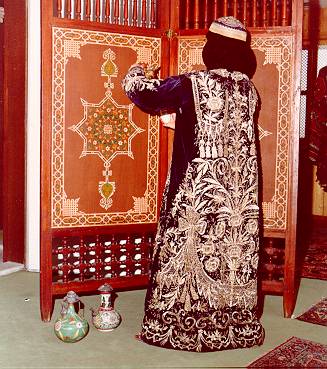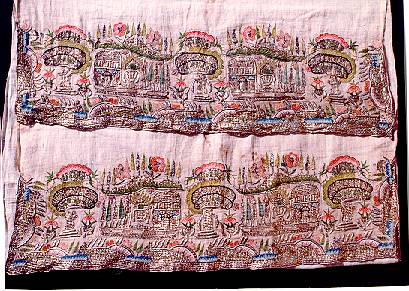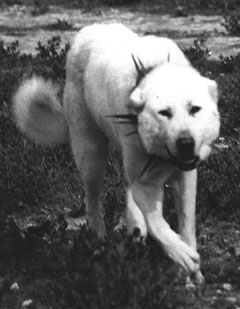BismillahirRahmanirRahim
Encountered this – a snapshot of embroidery in the Ottoman Empire :
——–
Turkish textiles & embroideries were immensely influential not only in those regions that were a part of the Ottoman empire, but further afield as well. The range of embroidery was considerable, and worked not just by professionals but domestically ; that is by women at home. Large numbers of men were employed as Professionals and there seem to have been a few workshops , in Istanbul at least , composed only of women . In addition there was a considerable cottage industry of domestic embroidery which was very much in demand throughout the Ottoman empire.
This domestic work was sold in the market by travelling salesmen and carried for sale all over the country and further afield to the Balkans, Hungary and Transylvania. The ‘Professionals ‘who were mainly men , were organised, like every other profession into very strictly – run craft Guilds . These Guilds regulated such aspects as quality control, training , prices and so on . It was Professionals , for example , who made and embroidered the georgeous but heavy velvet dresses (Photo No.1) illustrated on the screen. This ‘Kaftan’- like costume probably originating from the Ottoman court, was worn as a bridal dress in various towns of Turkey . Similar ‘Kaftan’s’ were worn by wealthy brides in Aleppo and Damascus in Syria, as well as in Palestinian towns of Jerusalem and Jaffa , and even as far away as urban Morocco and Algeria. Court costume in the Balkans and southern Russia developed from this style and and similar embroidery can be found as far afield as northern Nigeria and Mauretania .
illustrated on the screen. This ‘Kaftan’- like costume probably originating from the Ottoman court, was worn as a bridal dress in various towns of Turkey . Similar ‘Kaftan’s’ were worn by wealthy brides in Aleppo and Damascus in Syria, as well as in Palestinian towns of Jerusalem and Jaffa , and even as far away as urban Morocco and Algeria. Court costume in the Balkans and southern Russia developed from this style and and similar embroidery can be found as far afield as northern Nigeria and Mauretania .
In the Turkish kaftan style the floral embroidery is known as BINDALLI , meaning , “a thousand branches” and garments embroidered in this manner are called Bindalli . The connection would appear to have have reached as far as Malaysia and recently, while in Penang I watched such embroidery being worked on a Kaftan style material for a dress at a cultural exhibition .
The Kaftan with this type of embroidery seems to have been a development of ‘Khil’at’ or Robes of Honour’ that the Sultan presented to ‘worthy’ citizens , Ambassadors and important foreign visitors at Eid celebrations . The custom of leaders distributing costumes as gifts was an old pre-Islamic one in the Arab world and seems to have been common in Central Asia as well . There are records of the Khans of Bohara, Khiva, Turkestan , giving such robes to guests and visitors on important occasions. The value of these robes depended on the status of the person.
In Ottoman Turkey fine domestic embroidery was produced by women in wealthy houses as well as from homes in towns and villages . The women embroidered wall-hangings, cushion and bolster covers , turban covers, scarfs and sashes, trouser cuffs, their bedding and pillowcases and of course towels and napkins. They were executed for use for themselves ,and although they were in demand for the market were not made specifically for sale.
The most common of all domestic embroidered cloths are those known as towels or napkins – which is one translation of the Turkish ‘Peskir’ , and they were amongst the most constantly used articles in any home, both formally and in a domestic sense.
The traveller , Charles White in his three volume book ‘THREE YEARS IN CONTANTINOPLE, or Domestic Manners of the Turks’ published in l844 , writes that great use is made of textiles in the home and specifically mentions napkins .
(Photo No.2) (last quarter 19th century) He writes:
“Muslin and cotton handkerchiefs are employed less, perhaps, for the purposes to which such articles are applied in Europe, than for that of folding up money, linen and other things. In the houses of the great men, there is always a ‘Makramaci bashi’ , whose principal duty is to take care of these and other similar articles. No object great or small , is conveyed from one person to another, no present is made – even fees to a medical man – unless folded in a handkerchief, embroidered cloth or piece of gauze . The richer the envelope , the higher the compliment to the receiver.”
Charles White also noted that the Sultan honoured individuals by bestowing on them gifts, which were always given wrapped in an embroidered cloth , in the same manner as when letters or fees went to the medical man. This presentation of gifts most likely descended , at least partially from the regal traditions of the Byzantine empire . One of the earliest references to such’ Hankerchiefs’ is a letter written in 1560 by the Hapsburgh Emperor Ferdinand I’s ambassador to Constantinople , Ogier Busbeq . He mentions the Archery competitions held , probably in the Topkapi Palace in Istanbul , and states that the winner was presented by the Sultan with an embroidered cloth ” such as we use to wipe our faces” . Provincial governors and other high offiicials also received presents of embroidered scarfs or handkerchiefs in much the same way that Elizabeth I of England gave embroidered gloves to deserving courtiers.
————————————
Source: – http://www.trmkt.com/





